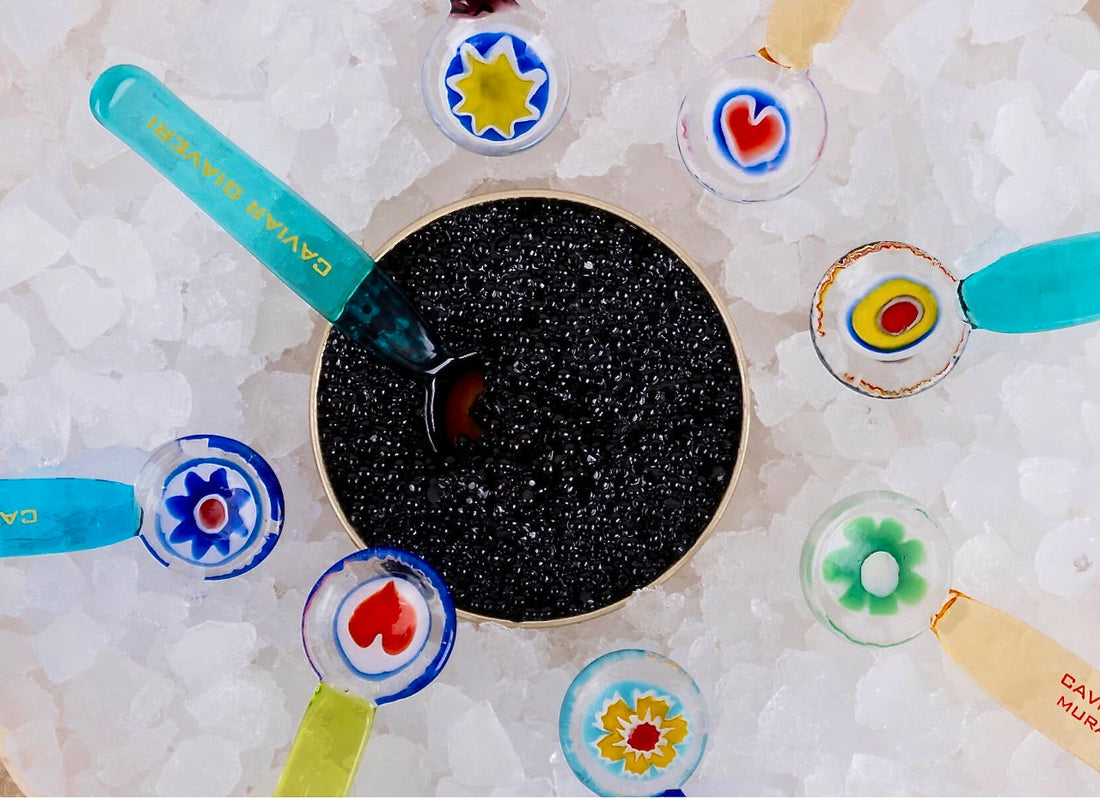Caviar might be the star of the show, but how you serve and eat it matters almost as much as the delicacy itself. One of the most hotly debated topics in the caviar world? The kind of spoon you use.
If you’ve ever seen caviar served at a high-end restaurant or in a luxury gift set, you’ve likely noticed the use of a pearl-like spoon instead of the usual silverware.
Is it just for show, or does it really make a difference? Here’s the scoop on why your choice of spoon can make or break your caviar experience.
The Science: Caviar and Metal Don’t Mix
Caviar is incredibly delicate, both in flavour and texture. When caviar comes into contact with metal—especially silver, nickel, or stainless steel—an oxidation reaction occurs. This reaction can happen almost instantly, imparting a strong metallic taste to the caviar and masking its subtle, briny notes. Even a brief touch with a metal spoon can alter the flavour, ruining the experience for anyone with a discerning palate.
“The reason caviar and metals don’t mix is due to the oxidation that occurs when caviar and metal come into contact. The oxidation in the metal tin has a reaction that makes the caviar have a distinctly metallic flavour imparted into the eggs, ruining the taste of the caviar.” Tony Rogalsky - Owner, Montello Gourmet.
Why Mother-of-Pearl Spoons Are the Gold Standard
The go-to for caviar connoisseurs is the Mother-of-Pearl spoons. Mother-of-Pearl SHELL spoons have been used for centuries in caviar service, not just for their non-reactive properties, but also for their beauty. Their shimmering surface has become a symbol of luxury and proper etiquette in fine dining.
Mother-of-Pearl (also called nacre) is a natural, non-reactive material formed inside mollusc shells—the same material that makes up pearls. When used as a spoon, it:
- Preserves the pure, unaltered flavour of the caviar.
- Provides a beautiful, iridescent contrast to the dark caviar pearls.
- Adds a touch of elegance to the presentation.
The important part of the mother-of-pearl spoons is the face of the spoon that will come in contact with the caviar. Some mother-of-pearl spoons have wooden handles, some have black handles, some are mother-of-pearl the whole way along the spoon. The handle makes no difference as it isn't touching the caviar.
Mother-of-Pearl spoons, can be cleaned with warm water and soap, preferably plant-based or castile soap.
Other Acceptable Spoons
If you don’t have a Mother-of-Pearl spoon, there are other non-reactive options:
- Horn: Made from animal horn, these are non-reactive and more affordable than Mother of Pearl.
- Pure Gold: A pure gold spoon would be incredibly heavy and incredibly valuable, but pure gold spoons are said to be the preferred spoon of Russian Tsars if a pearl spoon was unavailable. Gold is universally recognised as the most inert of metals, and so won’t have an impact on the taste of caviar.
- Glass: Glass spoons are also inert and allow for a beautiful presentation of the caviar. Ensure the edges are smooth to avoid damaging the delicate eggs.
- Wood (Unvarnished): Certain types of unvarnished wood, like olive wood or bamboo, can be used. However, it's crucial to ensure the wood is completely unsealed and free of any varnish or finishes that could leach into the caviar. Wood can also potentially absorb some moisture or flavour over time, so it's often considered a less ideal long-term serving solution compared to pearl or glass.
- Plastic: Not glamorous, but in a pinch, a smooth plastic spoon will do the job.
“Once I was on a camping trip and we’d remembered everything but the pearl spoon! I couldn’t believe it, I mean we were already roughing it, but not having a pearl spoon is practically savagery haha! Fortunately we had a clean plastic spoon available, so we made do, and enjoyed a wonderful evening in Victoria’s high country, with a spectacular view and some wonderful beluga caviar.” Tony Rogalsky - Owner, Montello Gourmet.
Talking Points for Your Next Gathering
- “Did you know that even a quick touch with a metal spoon can ruin caviar’s flavour?”
- “Mother-of-Pearl spoons aren’t just pretty—they’re essential for tasting caviar as it’s meant to be enjoyed.”
- “If you don’t have a pearl spoon, wood or horn will do, but never metal!”
So, next time you’re serving caviar whether it’s Beluga, Ossetra, or Siberian - reach for a Mother-of-Pearl spoon and savour every subtle note, just as the experts do.
Why Does It Matter? The Pursuit of Perfection
For true caviar aficionados, the goal is to experience the delicacy in its purest form. Just as wine connoisseurs carefully select the right glassware to enhance the aroma and taste of their wine, caviar lovers understand that the serving utensil plays a crucial role in the overall experience.
Using a non-reactive spoon, particularly one made of mother-of-pearl, demonstrates a respect for the quality and craftsmanship of the caviar. It signifies an understanding that every detail, no matter how small, contributes to the ultimate enjoyment.
So, the next time you're preparing to indulge in the exquisite offerings from Montello Gourmet, reach for a pearl, bone, horn, or glass spoon. It's a small change that makes a significant difference in preserving the integrity and enhancing the pleasure of your caviar experience. Trust us, your taste buds will thank you.


